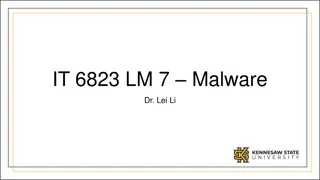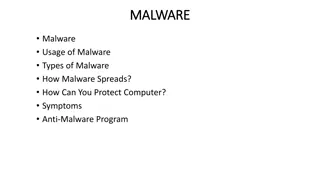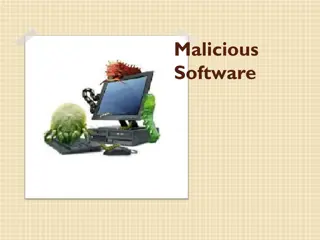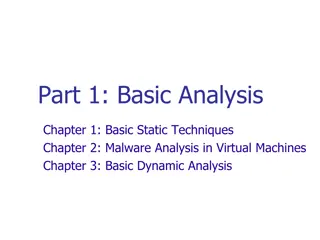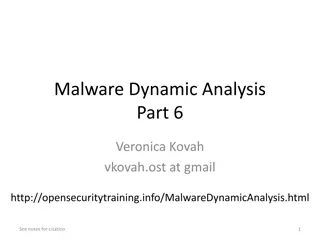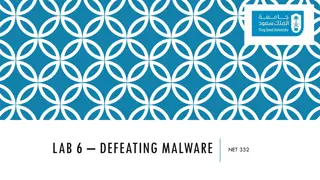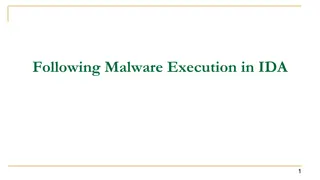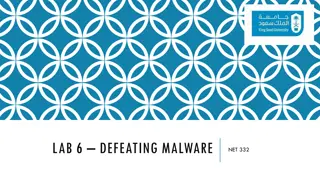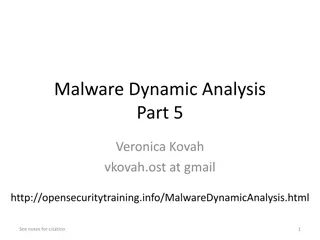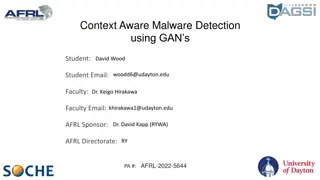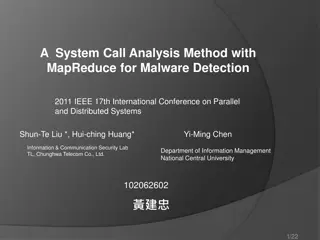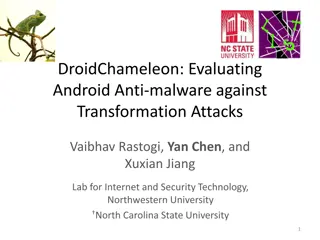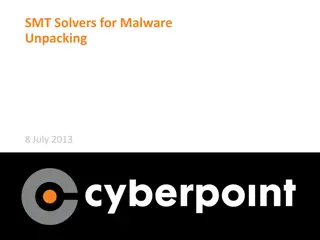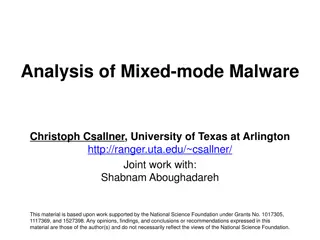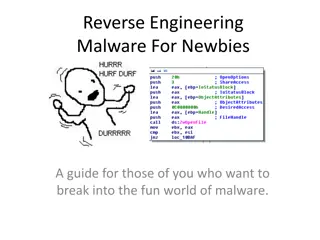Malware: Types, Impact, and Response Strategies
Malware, a term encompassing various malicious software types like viruses, worms, and ransomware, poses significant threats to cybersecurity. This content delves into the definition, types, kill chain analysis, incident response, and the MITRE ATT&CK framework in mitigating cyber threats.
Download Presentation

Please find below an Image/Link to download the presentation.
The content on the website is provided AS IS for your information and personal use only. It may not be sold, licensed, or shared on other websites without obtaining consent from the author.If you encounter any issues during the download, it is possible that the publisher has removed the file from their server.
You are allowed to download the files provided on this website for personal or commercial use, subject to the condition that they are used lawfully. All files are the property of their respective owners.
The content on the website is provided AS IS for your information and personal use only. It may not be sold, licensed, or shared on other websites without obtaining consent from the author.
E N D
Presentation Transcript
Black-box analysis of malware V t Buka CROCS, Faculty of Informatics, Masaryk University Supervisor IT Security, CIRT, Honeywell Global Security PV204 Security Technologies
Black-box analysis of malware Outline Lecture 1. Incident response 2. Malware 3. Black-box principle 4. Tools 5. Automatic sandbox analysis Hands-on lab Analysis of provided malware samples 2
Cyber Incident Response Cyber Incident Response A well-organized effort by which an organization handles a cyberattack, including analysis, containment, remediation and reduction of future risks. Good incident response results in: Lower costs of ongoing cyber incidents Fewer future incidents Cyber Kill Chain Each incident goes through certain phases Each phase can only continue if all previous phases completed successfully Collecting information about each phase helps detect/prevent future incidents
Cyber Kill Chain M Hutchins, Eric & J Cloppert, Michael & M Amin, Rohan. (2011). Intelligence-Driven Computer Network Defense Informed by Analysis of Adversary Campaigns and Intrusion Kill Chains. Leading Issues in Information Warfare & Security Research.
MITRE ATT&CK Framework Globally accessible knowledge base of adversary tactics and techniques based on real-world observations. Good learning point about advanced attackers Likely will replace kill chain https://attack.mitre.org/
Malware definition Malware, short for malicious software, is an umbrella term used to refer to a variety of forms of hostile or intrusive software, including computer viruses, worms, Trojan horses, ransomware, spyware, adware, scareware, and other intentionally harmful programs. It can take the form of executable code, scripts, active content, and other software. Malware is defined by its malicious intent, acting against the requirements of the computer user and so does not include software that causes unintentional harm due to some deficiency.
Malware types Trojan Fake AV Backdoor Remote Access Tool (RAT) Dropper Downloader Information stealer Keylogger Ransomware Coinminer Sniffer Virus Worm Spyware Adware Botnet 9
Malware infection vectors Email Link Attachment Link + document download Malicious website Drive-by download USB Cracked software Worms
Infection vector Phishing Subject Account blocked Package to be delivered Expiring subscription Invoice / Receipt / Parchment Signs Unexpected sender address (1) Graphic errors (2) Erroneous info (3) Links to unexpected URL (4) Links to same URL Generic salutation Use of threats, sense of urgency
Motivation Ask the right questions What is the scope of compromise? What are 2ndstage callbacks? Communication between local file server and an unknown IP address in China has been observed. What process is responsible for the communication? Malware is creating temporary files. Where are these files located? Malware executable is created again after system reboot. How is it possible and what is causing it? A new type of malware has been spreading through internal network. How to quickly assess the malware capabilities? What is its purpose? Is it based on any well-known tool? 15
Black box malware analysis Dynamic analysis file is executed Analysis without internal knowledge Observable inputs Observable outputs Quick, simple Common monitoring tools Collected indicators about Filenames, process names, process parent/child relationships, temporal relationships, domain names, IP addresses, registry keys, persistence methods, cleanup operations etc. Can be highly automated
Black box malware analysis Principle 1. Prepare analysis environment 2. Create snapshot 3. Run monitoring tools 4. Run malware 5. Collect and observe interactions between malware and VM 6. Restore snapshot 7. Repeat 3-6 as needed
Analysis environment Virtual Machine Limited/no connectivity Virtualized services (DNS, HTTP, ) Several VMs for various host types Software Monitoring tools Often exploited applications Risks VM isolation breach Malware inactivity in VM
Virtual machine snapshot Snapshots Saved state of VM Disk state, memory state Quick restoration of previous state
Network analysis Capturing sent/received packets Protocol dissection Promiscuous mode Tools Tcpdump, Wireshark, NetworkMiner Indicators Domain names, IP addresses, protocols, ports, HTTP parameters Q&A Who is this program communicating with? What reputation does the partner have? What data is exchanged? Is it encrypted or obfuscated?
Network analysis What to look for New established connections HTTP 80/8080 Direct calls for domains without DNS lookup Random domain names (e.g., rpxiodffd.biz) Suspicious domain names (e.g., gooogle.org) Similarly looking domain names (e.g., osinstall.biz, swinstall.biz, swinstall.com) Outgoing portscans Ping/DNS request for well known services Connection availability test Be aware of background OS/processes activities!
File system Observing file accesses and modifications Background file manipulation Tools Procmon, Handle Indicators File names, folder names, order of actions, compromise spread through local system Q&A Where is malware copied after the initial infection? What filenames are used? Where is the collected data stored?
File system What to look for New file names & folders New created files and folders Batch files (.cmd, .bat, .vbs, .ps1) Known favorite malware file names (e.g., 1.exe, test.exe, new.exe) Known file names in uncommon folders (e.g., C:\Temp\svchost.exe) Recycler Modifications of system files Temporary storage files, encrypted archives
Registry Regedit Windows built-in registry editor RegRipper Extracts relevant forensic artifacts from registry Autoruns Lists all programs set to start after system boot
Registry What to look for Well-known locations Autorun locations Task scheduler Changes tracking Keywords fulltext search Filenames Processes Domain names
Processes Observing initial system compromise Processes parent/child relationships Tools Process Explorer, Procmon Indicators Process names, order of execution, dropper activity Q&A What processes are run after malware binary is executed? Are batch files involved? Are there watcher processes?
Processes What to look for Order of executables Initial malware Dropper/downloader Persistence executable Final malware Command line interpreters cmd.exe Powershell Cscript, wscript
Executable file analysis Cryptographic hash Hash function which is considered practically impossible to invert Unique identification of file Counter: Polymorphism MD5, SHA1 Fuzzy hash Context triggered piecewise hash Families of files ssdeep Strings
Example Strings server.exe AppData 4bcce4de98bcdb4d29f66c0fe1ffe002 hackerhani.no-ip.biz Software\Microsoft\Windows\CurrentVersion\Run Software\ yy-MM-dd ??-??-?? Microsoft Windows SystemDrive netsh firewall delete allowedprogram " Software cmd.exe /c ping 0 -n 2 & del " SEE_MASK_NOZONECHECKS netsh firewall add allowedprogram " Domain name Persistence registry key Commands to be executed MD5: 5d347384ea978a96bc842ad9f29e95f2
Black box analysis indicator interpretation Network analysis domain & IP verification, processes communicating Hash comparison Collisions, same-hash files Behavior analysis System processes, created processes, persistence File manipulation 36
Document analysis Quick insight EXIF information File metadata Document sandboxing Document interpretation ambiguity Practical examples Double extensions, different content in different viewers, code block obfuscation & hiding
Automated sandboxing Automated 1. 2. 3. 4. Non-interactive Known tools Cuckoo, Norman, Anubis etc. Execute malware in sandbox Wait a few seconds Receive summary report Investigate report
Cuckoo sandbox Open source malware analysis system Can analyze Windows executables, DLLs, PDF documents, URLs, HTML files, PHP scripts, Visual Basic scripts, ZIP archives, Python files, etc. Modular, scriptable Full memory dump (for Volatility Framework) Django web interface Mongo (NoSQL) database
Internet sandbox services Public service OpSEC issues Huge comparison database Exact match by hash Similarity search by keywords Malwr.com (public Cuckoo sandbox) VirusTotal.com ThreatExpert.com Hybrid-Analysis.com
Operational security (OpSec) Advanced attackers monitor victim s actions Unique indicators visible on Google? Attacker host monitoring for incoming traffic Keywords search in mails, PDFs Basics of OpSec Think before you act mentality Limited information sharing Trace removal PassiveTotal.org
OpSec Basic rules No ping No DNS lookup No accessing to suspicious domains No premature remediation steps (reboot, antivirus scan, OS reinstall) No upload of samples No indicator validation on external sources NOT EVEN through 3rdparties
Anti-sandbox techniques Continuous development sandbox vs. anti-sandbox Malware inactive in analysis environment Tools presence detection (Wireshark, etc.) Virtualization detection Registry (key existence, key value) File system (file existence, drivers) Processes (syscall response) Human presence detection Mouse movement Keyboard activity File artefacts
Lab Overview Hands-on experience of manual black-box analysis Guided analysis of selected malware samples Tools Wireshark Network activity Process Monitor File system activity, process creation Autoruns Persistence Regshot Registry changes Process explorer Process map
Lab Samples 2-3 samples from different malware families Commodity malware Zeus, ZeroAccess, Generic Trojans, Students will execute samples in virtual environment Provided simple analysis virtual machine (Windows) Indicators collected network, files, persistence Discussion about interpretation of facts Homework 2 samples for analysis independently Write a cohesive report and present key information to the reader





